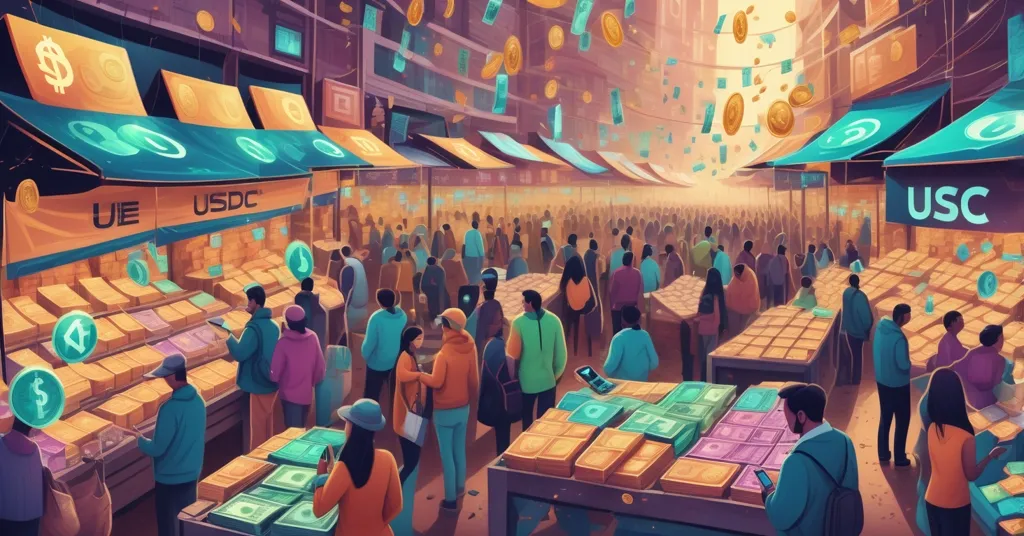Stablecoin Boom: USDT and USDC Reshape Economies in Argentina, Nigeria, and Turkey

Stablecoin Surge: How USDT and USDC Transform Economies in Argentina, Nigeria, and Turkey
From the chaotic markets of Lagos to the inflation-scarred streets of Buenos Aires, stablecoins like USDT and USDC have morphed from crypto oddities into critical lifelines for millions in high-inflation hotspots. These digital dollars are redefining savings, trade, and payments, empowering the unbanked, sidestepping sluggish banks, and challenging national currencies—yet they come with a hefty dose of regulatory heat, fraud risks, and systemic vulnerabilities.
- Grassroots Revolution: Stablecoins are now everyday digital cash for savings, business, and remittances in nations like Argentina, Nigeria, and Turkey.
- Economic Escape: They provide a hedge against hyperinflation and currency controls, bypassing costly, outdated banking systems.
- High-Stakes Risks: Fraud, centralized control, and looming government crackdowns threaten to undermine this digital dollarization wave.
Stablecoins 101: Digital Dollars Explained
For those new to the crypto space, stablecoins are a breed of cryptocurrency designed to hold a steady value, typically pegged 1:1 to a stable asset like the U.S. dollar. Unlike Bitcoin, which can rollercoaster in price, stablecoins such as Tether (USDT) and USD Coin (USDC) aim to mirror the dollar’s stability—think of them as digital cash often backed by reserves held by issuers. They’re a go-to for transactions and savings in regions where local currencies crumble under inflation or government restrictions, offering a practical alternative without the volatility of other cryptocurrencies. For a deeper dive into what they are, check out this comprehensive explanation of stablecoins.
Everyday Money in Failing Economies
In countries where trust in national money evaporates faster than morning dew, stablecoins have stepped in as a grassroots financial savior. Take Argentina, where annual inflation routinely soars past 100%, and strict currency controls—known as the “cepo”—limit dollar purchases to a measly $200 per month. Desperate citizens turn to black markets or crypto, often paying a 30% premium to snag USDT on platforms like Lemon Cash, Buenbit, or Binance. Why bother? It’s still quicker and cheaper than navigating banking bureaucracy or shady dollar dealers. Binance reported a staggering 150% spike in USDT trading volume in Argentina in 2024 alone. Martina Diaz, a freelancer from Buenos Aires, captures the shift:
“I get paid in USDT by international clients, keep some on Binance, and top up my prepaid crypto card to buy groceries. The banks are irrelevant.”
Across the Atlantic in Nigeria, the story echoes with even more urgency. After regulatory crackdowns banned bank-based crypto transfers, Nigerians pivoted to peer-to-peer (P2P) trading—direct exchanges of stablecoins for local currency without middlemen—using WhatsApp, Telegram, and even cash swaps. The scale is mind-boggling: P2P crypto trades hit $1.2 billion in Nigeria in 2024, per Chainalysis data. It’s a workaround for remittances and e-commerce, dodging the slow, expensive banking system. Chinedu E., a Lagos-based e-commerce merchant, explains the appeal:
“If I wait for a bank transfer, it takes days and costs too much. With USDT, I get money instantly and sell it to whoever offers the best naira rate.”
Yet, not everyone’s singing praises. The P2P scene is a cesspool of scams—fake deals and reversed payments are rampant. One Nigerian trader shared a bitter lesson: “I lost 50,000 naira in a fake USDT deal on WhatsApp—there’s no recourse.” Platforms like Azasend are trying to clean up the mess with safer fiat-to-crypto conversions, but informal trades still rule, exposing users to constant danger. Learn more about these risks and fraud cases in P2P stablecoin trading in Nigeria.
Then there’s Turkey, where the lira has lost over 80% of its value since 2020, fueling a stablecoin boom that reached 3.7% of GDP last year. Even with easier access to physical USD, digital dollars remain a preferred hedge against relentless devaluation. Yilmaz K., an Istanbul web developer, relies on USDT for stability:
“I price my contracts in USDT because clients and suppliers all trust it, and I dodge daily swings in the lira.”
These stories aren’t outliers—they reflect a global pattern of digital dollarization, where stablecoins fill the gaping void left by collapsing local currencies and inaccessible banking. For a broader look at their role, explore this discussion on how stablecoins support economies like Argentina.
Cross-Border Game-Changer: The Digital Sandwich
One of stablecoins’ knockout features is their ability to revolutionize cross-border payments. Picture a “digital sandwich” model: you on-ramp local currency to a stablecoin, transfer it instantly across borders via a crypto wallet, and off-ramp it to another currency at the destination. No middlemen, no SWIFT system delays, no bank fees that feel like highway robbery. Consider a freelancer in Buenos Aires sending $500 to a supplier in Lagos—they convert pesos to USDT, send it in minutes, and the recipient flips USDT to naira, saving $30 in fees and three days compared to traditional wires. McKinsey & Co. summed it up in their July 2025 report:
“Stablecoins slash payment times from days to seconds. Businesses see instant settlement and clear FX conversion. It is a revolution compared to legacy rails.”
The data backs this up: stablecoin transactions settle in under 10 seconds versus 2-5 days for bank wires, with fees often below 1% compared to 5-7% for traditional remittances. For small businesses and freelancers in high-inflation zones, this isn’t just convenience—it’s survival, freeing them from the Stone Age extortion of legacy finance. See more on their transformative role in a detailed analysis of stablecoin impact across Argentina, Nigeria, and Turkey.
The Bitcoin Maximalist Lens: Utility vs. Purity
As champions of decentralization, we can’t ignore the philosophical tension here. Stablecoins deliver undeniable utility for everyday transactions with their price stability, a niche Bitcoin—due to its volatility—often can’t fill. But let’s be brutally honest: most stablecoins, like USDT and USDC, are centralized beasts, tethered to issuers like Tether and Circle who hold the reins. Bitcoin bows to no one—its censorship resistance and trustless nature are unmatched, a pure rebellion against control. Stablecoins? They’re a compromise, vulnerable to corporate or government pressure. Are we trading crypto’s founding ethos for short-term pragmatism? It’s a bitter pill, but for now, stablecoins are a necessary bridge for adoption in unstable economies, even if they’re not the endgame of financial freedom.
Regulatory Roadblocks: The State Strikes Back
Here’s where the fairy tale gets grim. Stablecoins pose a direct threat to national monetary sovereignty, and governments are waking up with a vengeance. In Argentina, tax authorities now demand reporting of stablecoin balances over $2,000—a clear signal of tighter scrutiny. Nigeria’s Central Bank, after partially reversing a total crypto ban, rolled out a “Crypto Regulatory Sandbox” in 2025, requiring exchanges to track user identities and report trades over $1,000. Yet, P2P volumes surge underground as users dodge the rules. Turkey’s new oversight laws mandate national exchanges to verify funds within a “Supervisory Sandbox.” Globally, the U.S. and Europe are pushing for reserve transparency, Know Your Customer (KYC) regulations, and “travel rule” compliance to trace transactions. Stay updated on these shifts with insights into recent regulatory updates on stablecoins in these regions.
Zoom in on Nigeria’s sandbox for a taste of the impact: while it aims to legitimize crypto, it pushes small traders into riskier informal markets to avoid ID checks and reporting. Even worse, U.S. SEC scrutiny of Tether’s murky reserve claims could trigger asset freezes, rippling to users worldwide. The EU’s Markets in Crypto-Assets (MiCA) regulation, effective since 2024, demands full reserve audits—potentially a blueprint for global standards. Governments aren’t playing around: adapt to their rules, or get crushed. This tug-of-war between user demand and state control is the battlefield stablecoins must survive.
Risks and Red Flags: Ticking Time Bombs
Let’s cut the hype and face the ugly truth—stablecoins are a double-edged sword. Beyond regulatory heat, the P2P trading scene is a Wild West of fraud. Scammers pose as buyers, reverse payments after trades, or use stolen accounts, leaving victims with no recourse. In Nigeria, disputes over payment confirmation and bank account freezes—flagged as suspicious—are everyday headaches. Even safer platforms like Azasend charge premiums, so informal trades remain a gamble for many.
Then there’s the systemic fragility. Remember TerraUSD (UST) in May 2022? This algorithmic stablecoin lost its peg due to a cascading failure tied to its sister token LUNA, wiping out $40 billion in value. Users in high-inflation regions, who parked life savings in UST for “safety,” were obliterated. Could USDT be next? Tether’s refusal to provide consistent, transparent audits of its reserves isn’t just a red flag—it’s a neon sign screaming “proceed with caution.” If a major stablecoin de-pegs or an issuer faces legal heat, trust in this ecosystem could shatter overnight. Centralized control by entities like Tether and Circle only amplifies the risk—unlike Bitcoin, these digital dollars aren’t immune to external meddling. For more on these concerns, read about the risks tied to USDT and USDC in volatile economies.
Playing devil’s advocate, are stablecoins even a real solution? Or just a shiny Band-Aid distracting from deeper rot like financial illiteracy and broken infrastructure? They empower individuals to escape failing fiat, sure, but without addressing systemic flaws, they’re a temporary fix at best—potentially lulling users into a false sense of security while bigger cracks fester.
Future Outlook: Integration, Crackdown, or Chaos?
Peering into the crystal ball, stablecoins in local economies face three possible fates. First, regulated integration: governments could embrace them with clear rules, lowering fees and boosting financial inclusion—think the EU’s MiCA framework as a model. Second, fragmented crackdowns: outright bans or harsh restrictions, like China’s 2021 crypto purge, could drive usage into black markets, stifling innovation. Third, a messy hybrid of controlled tolerance: strict monitoring, KYC mandates, and competition from central bank digital currencies (CBDCs) like Argentina’s rumored digital peso. I’m betting on the hybrid—it’s chaotic but reflects the real-world clash of user needs versus state power.
CBDCs add another twist. They might offer government-backed stability, but lack the borderless, permissionless edge of stablecoins. If Argentina’s digital peso launches with incentives or mandates, it could undercut USDT’s appeal—yet in trust-scarce regions, state-backed anything is a hard sell. Could decentralized stablecoin alternatives, like DAI with its algorithmic peg and community governance, eventually outshine centralized giants? Or is centralization an inherent flaw stablecoins can’t shake? The jury’s out, but one thing is clear: this financial experiment is far from settled. For a closer look at emerging patterns, review the 2025 trends in stablecoin adoption across these countries.
As a nod to our effective accelerationism ethos, let’s recognize stablecoins as a battering ram against creaky legacy systems. Flawed? Hell yes. But they’re forcing finance to evolve or die, accelerating disruption even if they’re not the pure vision of decentralization Bitcoin embodies.
Q&A Spotlight: Key Takeaways on Stablecoin Adoption
- What are stablecoins, and why do they matter in high-inflation regions?
They’re digital currencies pegged to stable assets like the U.S. dollar, offering a reliable alternative to collapsing local money for savings and trade in places like Argentina and Turkey. - How do stablecoins enable financial freedom?
They sidestep banks and currency controls, allowing users to save, spend, and send money globally with minimal fees and near-instant speeds. - What risks do stablecoin users face?
Fraud in P2P trades, potential de-pegging disasters like TerraUSD’s collapse, centralized issuer vulnerabilities, and tightening regulations all threaten stability and trust. - How do governments view stablecoin adoption?
Most are wary, implementing KYC rules, regulatory sandboxes, and reporting mandates to protect monetary sovereignty while cautiously testing integration. - How do stablecoins compare to Bitcoin in unstable economies?
Stablecoins provide short-term price stability for daily use, but Bitcoin’s decentralization offers unmatched resistance to censorship or issuer failure, aligning with true financial sovereignty. - Will stablecoins survive regulatory pressure?
Probably in a hybrid model—competing with CBDCs and facing strict oversight, but their borderless utility will keep them relevant in regions lacking trust in traditional systems.
Stablecoins are a raw, messy experiment in economic autonomy, slashing payment times and empowering the unbanked to rise from the ashes of failing fiat. But the path ahead is a damn minefield—scammers prey on the desperate, issuers teeter on shaky ground, and the state’s iron fist looms large. Here at Let’s Talk, Bitcoin, we see stablecoins as a flawed yet fierce accelerator of financial disruption, shaking the foundations of legacy systems even if they lack Bitcoin’s untouchable freedom. The real battle is whether this grassroots rebellion can outrun regulation—or if it’s just a fleeting spark before control clamps down. Will digital dollarization truly liberate, or is it a temporary patch before the state rewires the game? For additional perspectives, browse community discussions on USDT and USDC usage in high-inflation areas.



